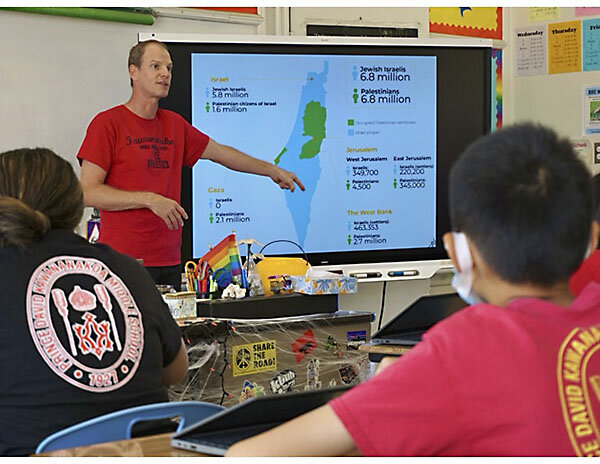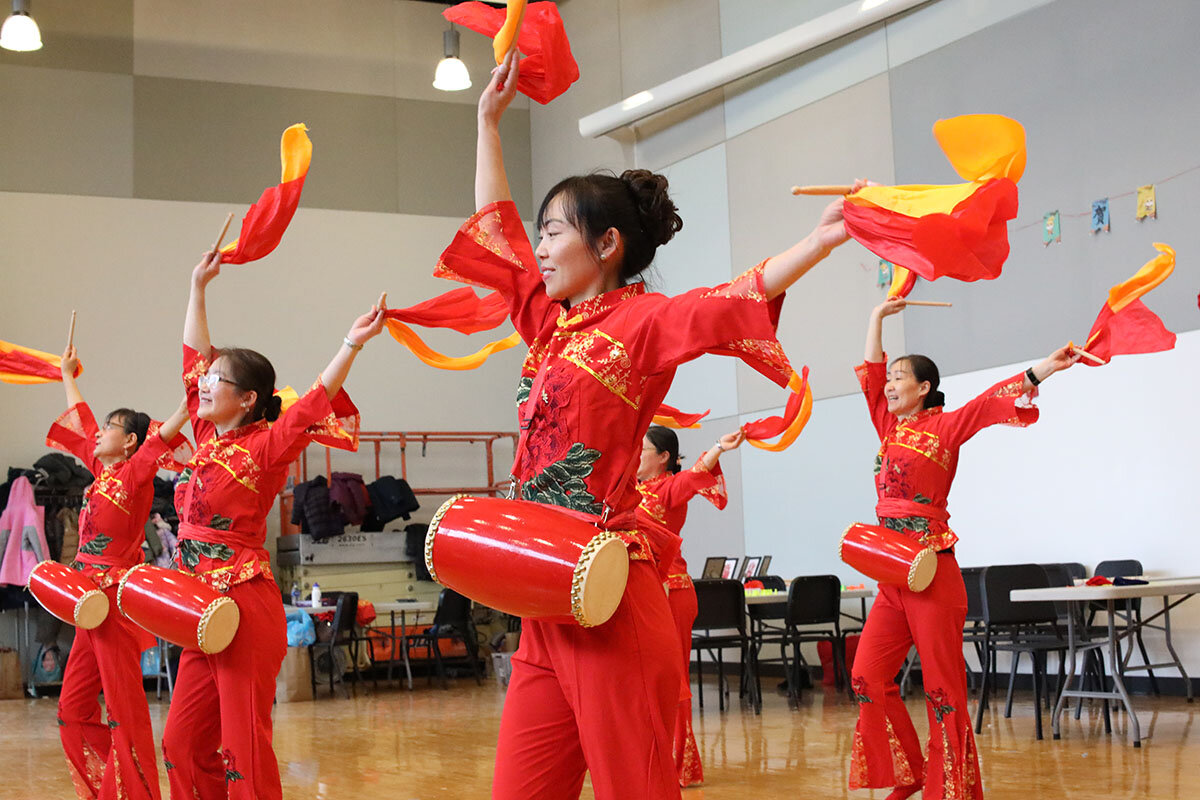‘The elephant in the room’: How US schools are talking about the Mideast
Loading...
How do you create “compassionate global citizens”? That’s the question facing U.S. schools in the throes of the Israel-Hamas war.
What that looks like at the Kawananakoa Middle School in Honolulu is students comparing and contrasting a natural disaster – the deadly Maui wildfire in August – with the human-created conflict in the Middle East. It also includes a teacher and student teacher pairing up to offer a lesson on recent history in Eastern Europe and the Middle East.
Teachers are not telling students what or how to think about the complex situation in Israel and Gaza, says Vice Principal Bebi Davis. Instead, they are nurturing intellectually curious students.
Why We Wrote This
A story focused onThe job of helping young people and their families process the Israel-Hamas war is often falling on educators. Finding a way forward includes making sure students feel physically safe, but also supporting their curiosity and thoughtfulness.
“You don’t want to keep them so sheltered that when they’re faced with a challenge, they don’t know how to balance their thoughts and emotions,” Dr. Davis says.
The approach offers a window into how K-12 educators are grappling with teaching amid a divisive global conflict. High schoolers are staging walkouts, student journalists are writing editorials using the term genocide, and in at least one case, students have threatened a teacher. School responses to spikes in antisemitism and Islamophobia in the United States have ranged from beefed-up security and intentional lessons – like those at Kawananakoa Middle School – to leaning into affinity groups to help foster understanding.
The emotionally charged moment makes schools even more important, says Joey Hailpern, a member of the Evanston/Skokie School District 65 Board of Education in Illinois.
“That’s the obligation that we have – to develop better citizens and a stronger community and to model what it’s like to do the work of bringing people together, so that they can leave our education spaces into the world together,” says Mr. Hailpern, a former teacher and principal.
“A turning point”
Since October, the Education Department’s Office for Civil Rights has opened more than a dozen investigations at K-12 and higher education institutions after alleged discrimination based on shared ancestry or ethnic characteristics. Several of the nation’s largest K-12 school systems – in New York, Las Vegas, and Tampa, Florida – are among those under investigation.
Rania Mustafa, executive director of the Palestinian American Community Center in Clifton, New Jersey, says some private Islamic schools have canceled outdoor recess and altered pickup procedures in a bid to bolster student safety.
Zainab Chaudry, director of the Council on American-Islamic Relations office in Maryland, says the group has received reports of female Muslim students wearing hooded sweatshirts in place of their traditional hijabs, while others are shying away from revealing their Palestinian American identity to classmates.
When Ms. Mustafa’s sixth grade nephew wore his keffiyeh, a traditional Palestinian garment, to school, another student called him a terrorist, she says.
“This has been a turning point in our communities, where now we are beginning to realize the importance of speaking up,” Ms. Mustafa says. In the case of her nephew, he told a guidance counselor.
Jewish schools, too, have increased security amid threats. And Jewish students have been subject to bullying and harassment, especially as their peers are “blurring the lines” between antisemitic rhetoric and criticism of Israel, says Aaron Bregman, director of high school affairs for the American Jewish Committee.
“Just because they’re Jewish, students are being essentially connected to the Israeli government,” he says. “It gets them scared. It gets them intimidated.”
“Dialogue is the only way”
Apart from hardening physical infrastructure, schools are sorting out how to start and continue conversations.
Some schools or districts have remained silent, forgoing any public statements or sidestepping discussion with students. In New Jersey, the Palestinian American Community Center questioned one district seemingly taking that approach, and after an inquiry, administrators changed course, says Ms. Mustafa.
At the very least, she says, schools should be providing mental health support to students affected by the conflict. But she also sees schools as a “controlled environment” where children can discuss and learn about these challenging topics – as long as they’re not politicized in favor of one side.
“At the end of the day, dialogue is the only way that anyone can move forward as a society and as a community,” Ms. Mustafa says. “Ignoring the elephant in the room is never the solution.”
The American Jewish Committee recently issued guidance for how public and private schools could confront antisemitism. The recommendations include, among others, training staff on how to discuss the conflict, supporting affinity groups, and hosting interfaith panels.
In an age of polarization, Mr. Bregman, of the American Jewish Committee, says it’s especially important to introduce students to the nuance underpinning global events.
“There’s not just one solution and ... there’s just not one answer,” he says. “And the more that kids have that discourse to talk this out, the more that we’re going to be in a better place moving forward and that nothing like this ever happens again.”
“Hate has no home here”
In Evanston, Illinois, two board members took it upon themselves to set the example. Mr. Hailpern, who is Jewish, co-wrote a letter with fellow board member Omar Salem, who is Palestinian. The letter acknowledges the pain caused by the conflict while also affirming the district’s schools as a safe space for students. “While processing and healing as a community, hate has no home here,” it states.
Mr. Salem says he thinks the letter, sent to district staff and families, offered a slice of hope and kept the focus on the children. “We can’t change what governments are going to do. But we can focus on Evanston Skokie District 65 and our kids and our community members,” he says.
In other places, cultural appreciation initiatives that took root before the Israel-Hamas war are proving helpful.
Two years ago, Beachwood City Schools – located in a diverse suburb outside Cleveland – launched family-led affinity groups after a parent brought concerns regarding language barriers to the administration, says Kevin T. Houchins Sr., the district’s director of equity and community engagement.
The groups serve as a place where parents can connect, support, and encourage each other while also improving cultural understanding in a district where 42% of students are white, 25% are African American, 21% are Asian, 8% are multiracial, and 4% are Latino. Beachwood is also known for having a large Jewish population.
Affinity groups exist for families of African American, Chinese, Hispanic and Latino, Indian American, Muslim, and neurodiverse students. Israeli families plan to start one as well, Mr. Houchins says.
The district community is “taking the time to actually listen and absorb and immerse ourselves into different cultures,” he says. “It has been really exciting.”
The groups hold their own meetings but also participate in quarterly “seat at the table” get-togethers, where district leaders listen to concerns and suggestions, Mr. Houchins says. From that feedback, Beachwood City Schools updated its academic calendar, closing schools on the Muslim holiday of Eid al-Fitr; for Diwali, the Indian festival of lights; and for Lunar New Year in Chinese culture.
The groups have been organizing cultural events, too, drawing families that previously had not participated in many school-based activities, says Mr. Houchins. He saw evidence of the growing cross-cultural bonds when affinity groups reached out to the district after the Oct. 7 attack on Israeli citizens that launched the war and asked how they could help.
“As they begin to learn more about each other, it helps us in times of crisis,” he says.
In Honolulu, it was a newsletter to families that explained the “global citizens” idea and detailed how educators are addressing the Israel-Hamas war.
Absent discourse and learning at school, Dr. Davis, the vice principal, worries students will resort to their phones for a less reliable source: social media. And she never wants to stifle curious minds.
“Kids want to talk about everything,” she says.
Even the difficult stuff.








